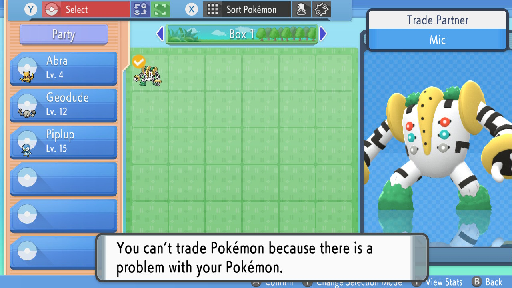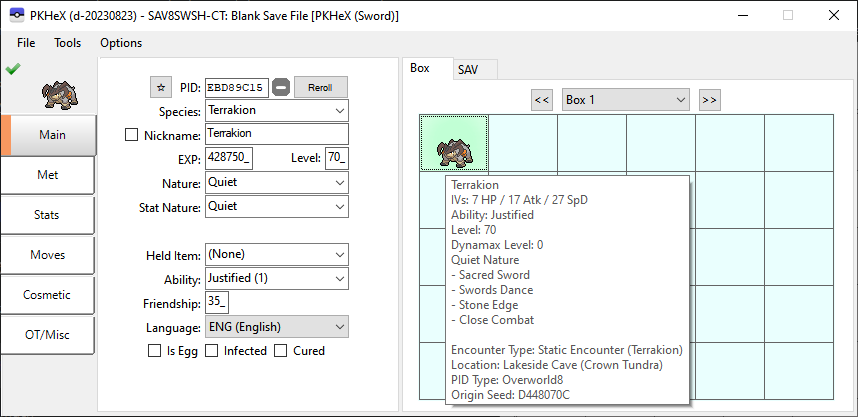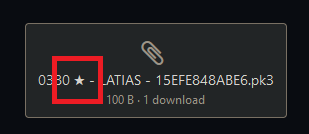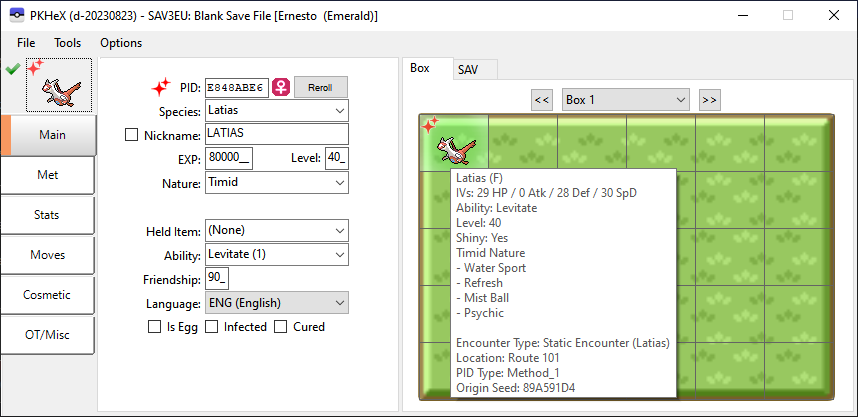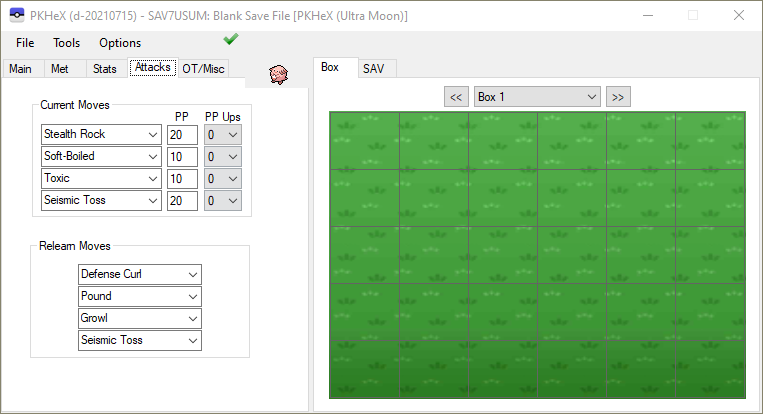-
Posts
28 -
Joined
-
Last visited
-
Days Won
4
Content Type
Profiles
Pokédex
Portal
Technical Documentation
Pages
Tutorials
Forums
Events
Downloads
Gallery
Blogs
Everything posted by Nuren
-
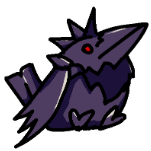
Need help verifying my Arceus' legitimacy - Strange Circumstances
Nuren replied to Veganator's topic in Pokémon Legality
Moving a Pokémon into BW does not change the origin game to BW. It wouldn't be one you caught in gen 4. It's probably a wildly illegal Pokemon you got somewhere else. -

Local trade in Pokemon SV is not working :/
Nuren replied to veteranzelda's topic in General Development
If one switch has ldn_mitm and the other doesn't, they won't connect. Disable it on your CFW Switch by going into the config. -
Each 3DS region has limited countries and subregions, and each combination of a country and subregion is assigned a pattern. Your Vivillon pattern depends on what your 3DS was set to when you started the game, not what it is at the time of hatching. The Egg's region information depends on what the 3DS was set to when the egg was generated. Trading does not change the pattern or 3DS region on the egg. The reason so many patterns are valid is because you can freely change your country/subregion as long as it's within the same console region. As long as any combination of country/subregion can have that pattern on that region 3DS, the pattern is possible with any of its country/subregion combinations. PKHeX will flag them as "fishy" in verbose legality (ctrl + click the check) if the country/subregion doesn't naturally have that pattern. The message will be about non-native Vivillon pattern. Use this site for the following example of how this works: https://www.pocketmonsters.net/content/Vivillon_Location_List Say your 3DS is region E (PAL) and you have it set to Australia/Tasmania when you create your game. This sets your pattern to Garden. You create your game and get to the nursery. You collect an egg. This egg will be Garden pattern and the region/subregion on it will be Australia/Tasmania. You then change your console region/subregion to Albania/Shkodrës (this is also possible on an E or PAL system). Normally this combination would be Marine pattern, but since the game was already created as Garden, it will still be Garden. You collect a second egg. This new egg will be Garden pattern and the region/subregion on it will be Albania/Shkodrës. PKHeX will mark this as "fishy" in verbose legality because normally, this combination should be Marine. You now trade both eggs to a JPN console. Both will still hatch as Garden pattern, with the original regions when they were collected.
-
No, that is incorrect. SysBot uses Auto-Legality Mod, which can create any Pokémon that is legal in PKHeX. Regardless, OP isn't using SysBot to create a Pokémon. They're uploading a file which is legal in PKHeX. The issue isn't in SysBot or PKHeX. If you try manually trading the file, you'll find that Regigigas doesn't trade online. Since this is on the game server side, every bot will fail.
-
The vast majority of what I knew at first was from testing and observing, as I said before. I keep a large database of Pokémon that are legitimate or most likely legitimate (from trusted users) to check whenever I have a question. Pporg has some technical documents here: https://projectpokemon.org/home/docs/ There are other sites you can look for to learn what others have made public. Smogon has some older threads for research: https://www.smogon.com/forums/threads/past-gen-rng-research.61090/ Even Bulbapedia has some information about the different kinds of RNG used: https://bulbapedia.bulbagarden.net/wiki/Pseudorandom_number_generation_in_Pokémon As well as Pokemon data structures: https://bulbapedia.bulbagarden.net/wiki/Pokémon_data_structure_(Generation_IV) There are some databases of mostly legitimately obtained Pokémon data that you can look at. RoC's PC is well known: https://github.com/ReignOfComputer/RoCs-PC (there may be some hacks in there). I also keep one here that is public: https://github.com/Lusamine/Anubirb If you are interested in RNG correlations, you can look at RNG manipulation tools to see how the math is done. One example is Pokefinder: https://github.com/Admiral-Fish/PokeFinder Honestly, you could read through this legality forum and see answers to other questions to learn more.
-
I am repeating myself at this point. I will not provide all the information you want, or any simple yes/no answers, because: There is too much information even if I wanted to provide all of it. I could write a textbook. There is no easy 15-minute tutorial to become an expert in Pokémon legality. Context for the Pokémon matters, and the answer will change for every case. You are asking for highly technical information beyond PKHeX legality checks, in a manner that can easily be used to help people lie to others. I am not interested in breaking the rules of the site, or providing public information that will be used for harm over good. Your question does not align with the topic of this thread. If you only wanted to help regular players who can access a PKM file hack check, we have provided the answer multiple times in this thread. (Look for strictly illegal traits, using PKHeX if you want. Then look for improbable traits. Assess the situation. Make your own decision.) What I know, I have learned from years of playing the games, experimenting, and observing. You can do the same thing by viewing the data of legitimate Pokémon in PKHeX. Many older mechanics are documented on the internet. This is what we are encouraging you to do when we say that you must research what you want to know.
-
The reason I will not provide more details is that you are asking about cases that are not immediately flagged red by PKHeX. You are asking me to tell you whether a hack is good enough or not that a human cannot distinguish. These details will never affect anyone playing the story with hacked/legal Pokémon, but will be used to lie to and trick others into thinking their Pokémon are legitimate. You are asking me to write an absolute massive amount of information that is only going to help people cheat. Your question about whether wild Pokémon (assuming SV) have a correlation like Tera Raids was answered already on the first page of this thread. PKHeX provides a fairly robust, basic legality check. A standard user who knows nothing and can get a PKM file can look at the legality check. If that user wants to know more, such as the chance of anything else happening, or what PKHeX does not handle, they must do further research themselves. The "non technical" player needs to become a "technical" player at this level. I am not going to respond to any more questions that are similar.
-
I feel like you are still trying to get an answer to a question that I said is too complex to answer. I am not going to provide an answer for every scenario you can think of. It is up to you to do the research yourself, like all of us in this thread have told you already. Pick the game, pick the encounter, research it thoroughly. Research how a Pokémon can be changed in game, and how you can move them around. Then answer it yourself. I am not going to provide a hack check to Pokémon that you hacked. You already said you hacked them, so they are illegitimate, and they may or may not be illegal. Providing you the specific details that are suspicious or wrong, if they are not flagged by PKHeX, would be helping people to lie to others. I think that you are conflating the different levels and abilities for people to hack check. Your question for this thread is for non technical users to hack check, which to me implies casual players who do not have CFW. This has been answered already (look for impossible values, then look for improbable traits).
-
Your question does not make sense. If someone makes a Pokémon that is exactly the same as a legitimate Pokémon, then there is no difference. Every single byte will be the same. If someone makes a Pokémon that is not perfectly the same as a legitimate Pokémon, then the differences are what need to be analyzed. There is no easy answer for how suspicious every single detail is. That requires you to research the specific Pokémon encounter and the specific detail. It is impossible to answer this question for every single possible Pokémon, because there are too many details and years later, there may be new findings that change the analysis. > can I create a Pokémon that is both legitimate and reasonable? Created Pokémon are never legitimate. They can be legal and reasonable. If you are asking whether using the default tabs in PKHeX to edit Pokémon can create a legal and reasonable Pokémon, again, the answer is yes, depending on what you change.
-
If a user perfectly recreates a legitimate Pokémon, then there is no way you can tell. Most people who gen Pokémon do not perfectly recreate legitimate Pokémon. I am not going to go into this in more detail because that would be straight up telling people how to create better hacks in order to fool other people. If you are asking about clones, the only way to verify a clone is to see another copy of it, assuming the Pokémon is not a natural clone. This is like asking "Is it possible to commit a perfect crime and never be caught?" It may be easier to think of hack checking like a court case. You must look at the suspect, the circumstances of the crime, any evidence that is available, and what any witnesses can tell you. The only ways to know if a Pokémon is legitimate is for you to either catch it yourself (and know all the circumstances of capture), or observe someone else do it and then check their console/setup to ensure no cheats are active. That means for most cases of Pokémon you receive from others, you cannot be 100% sure that it is legitimate. In the same way, the suspect knows 100% whether they committed the crime or not, but the jury may not know. Everything else is going to be a level of suspicion depending on the user and the mon. Here are some examples to think about: If your best friend says "I caught a shiny Pikachu legitimately with no cheats/hacks" do you believe them? What if your best friend's Pikachu was Timid 31/0/31/31/31/31 on top of being shiny, do you still believe them? What if a random stranger on the internet told you the two above, do you believe them? What if a user with a known hacker OT/TID on the internet told you the two things above, do you still believe them?
-
No, this is not fully accurate. I think you are confusing legality and legitimacy. This is probably a problem with translators giving the same word in other languages, but the two words are used differently when discussing hacked Pokémon. Again, it will depend on the encounter. Some encounters are more thoroughly checked by PKHeX, others are not. When knowledge is fully known, yes it is possible to fully determine the legality of a wild-caught Pokémon. Legality checks are always improving, so something that is currently not flagged may be flagged in the future. If you rely on a program like PKHeX and want to know how good each check is, that would still require you to do research into the encounter and the program. Remember that legality is not legitimacy. PKHeX does not do legitimacy checks. It does legality checks. Legality is whether it is possible to obtain a Pokémon that has those details. A legitimate Pokémon was obtained properly through the correct methods in-game. Fully determining legality does not fully determine legitimacy. A hacked Pokémon can be legal, but a hacked Pokémon is by definition not legitimate. The only way to know that something is fully legitimate is to know the exact circumstances used to capture the Pokémon. Otherwise, without knowing how it was obtained, the best you can do is compare to what is known to be possible. As I said before, it is possible to prove something is 100% hacked if it has 100% impossible features. Otherwise, you should take into account how likely that Pokémon is. It would be wrong to say that a 6 IV wild shiny Pokémon with 1/549755813888 chance is equally likely as a random IV, nonshiny Pokémon with nothing outstanding, simply because there are no strictly illegal features. PKHeX does not rate whether one Pokémon is more likely than another; that is for the user to research and understand. Yes, it is possible for a hacker to completely copy the details of a legitimate Pokémon. But you are not likely to see people hacking Pokémon that are exactly the same as random wild Pokémon. You have to look at the Pokémon yourself, research to know what is possible to figure out the chance of it occurring, and make the decision based on that knowledge. PKHeX can tell you that the values are possible, but that does not mean a sensible human should believe that odds of 1 in billions is as reasonable as a random Pokémon. Most trade communities do not expect casual users to have full access to the Pokémon data and research, so that is why they use methods such as listing known hacker OTs and general tells that are more associated with hacked than legitimate Pokémon. For example, Mitsuki.TV is a known streamer who distributes hacks. Yes, it's possible that someone innocent might pick Mitsuki.TV as their name. But do you really think an innocent user picked the same name as a streamer, found a legitimate shiny 6 IV legendary, and then gave it to you for free?
-
Anything you can bump into and start an encounter with is going to use Overworld8. You can pull one from the encounter database (Tools > Data > Encounter Database, filter Terrakion from Sword or Shield) and hover over it to see what the method is, so you don't have to keep asking.
-
SWSH Regis are not raid Pokémon or overworld Pokémon, so they do not use those spreads. They are scripted static encounters that are purely csprng, so any values you want to set are legal, including if you simply catch one and shinify it. And yes, even though Regigigas appears in a raid den, it's not a real raid den and doesn't use raid correlation. It's still a scripted static encounter.
-
The only way to tell that a Pokémon is 100% hacked is to find a trait that is 100% impossible. If you do not have access to the data and can only view in-game summary screens, that will limit your ability to see impossible traits. Even with access to PKHeX, there are some traits that are highly improbable but still legal. As others have said before, knowing what is an impossible trait or an improbable trait requires knowledge about the game and encounter. That kind of information could fill textbooks. An impossible trait might be easily visible, such as an impossible Poké Ball or a shiny-locked Pokémon that is shiny. Likewise, an impossible trait may require you to have the data, such as calculating the RNG correlation for SWSH Pokemon which requires hidden values such as PID and EC. Many users use common streamer OTs as a sign that a Pokémon is very likely to be hacked, even if the Pokémon is fully legal. The chance of a random wild Pokémon in SV with no fixed IVs to be shiny and 6 IV is at best 1 in (512 x 32^6) and it's very common for people to use these kind of odds as reason to find a mon suspicious. You're looking for something like this page, but there isn't a resource with every tell possible for every game. That requires the user to do the research. I believe that page is also not completely up-to-date, so some of the information on there has since changed due to new mechanics.
-

Why PKHEX mark my Latias as illegal when it shouldn't be
Nuren replied to Suri's topic in Pokémon Legality
> Why PKHEX mark my Latias as illegal when it shouldn't be None of your picture show Latias being marked as illegal. They would have a red triangle if illegal. > it supposed to be shiny and perfectly legal but in PKHex it is not shiny having the correct PID and the Seed and everything The file you uploaded is shiny and legal though? Perhaps you should update PKHeX like it suggests in the top right. I don't think that's the cause of your error but it's still best to be on the latest version. -
Would you happen to have unmodified examples of these shiny-locked HOME gifts from the same HOME account? There may be some interesting handling due to your HOME trainer ID. The first 6 are easy to get. https://projectpokemon.org/home/files/file/4046-home-starter-bulbasaur/ https://projectpokemon.org/home/files/file/4047-home-starter-charmander/ https://projectpokemon.org/home/files/file/4048-home-starter-squirtle/ https://projectpokemon.org/home/files/file/4049-first-wonder-box-trade-eevee/ https://projectpokemon.org/home/files/file/4044-first-gts-trade-rotom/ https://projectpokemon.org/home/files/file/4042-first-challenge-pichu/ https://projectpokemon.org/home/files/file/4055-national-dex-completion-magearna/
-
Known issue that we call "evotree". Basically, PKHeX doesn't account for changes in evolution methods between games. This will be fixed eventually, just not soon. You can read here if you want to know how big the problem is and what all has to be accounted for to fix it properly: https://github.com/kwsch/PKHeX/pull/3359#issuecomment-1003808371
-

PKhex flags the memory area of "somewhere" as invalid in BDSP
Nuren replied to carefree_dude's topic in PKHeX
This is a known issue that affects Pokemon that have moved through Bank and then HOME. The Pokémon are typically missing an HT language and have a link trade memory of being met "somewhere". -
It isn't both options in BDSP; there is a specific list of Pokemon that require 255 friendship (they say "Ssshhhnnn..."), and everything else requires the 30 levels gained. Some examples: My met level 80 Arceus from SP does not get the ribbon even with 255 friendship and at level 100. My met level 70 Articuno from SP doesn't get the ribbon with 255 friendship, but does get it after it is at level 100. My met level 70 Regigigas from SP doesn't get the ribbon at level 100, but does get it after it gains 255 friendship.
-

Gen8 (SWSH) Berry Tree IV Searcher Encounter Type
Nuren replied to finalevil151's topic in Pokémon Legality
Tree Pokemon IVs are generated with csprng as far as we know, not the same as Overworld8. -
Should be fixed in development build / next stable release; thanks for the report!
-

General question regarding HT/WT box in PKHEX.
Nuren replied to Skarwind's topic in Pokémon Legality
There is no species-specific height/weight calculation for SWSH. Height and weight do not necessarily need to be correlated either; any height and weight combination for a given species can be generated by some specific case of the RNG. There are tall/thin Lopunny, tall/fat Lopunny, short/thin Lopunny, and short/fat Lopunny. Height and weight are triangularly distributed, which means middle values are more common than extremely small or large values. PKHeX only enforces height and weight for a few SWSH cases like overworld encounters (fishing, grass, overworld legends) and HOME events that are forced to have 0 height and weight. You can pretty much put any values for most encounters otherwise. PoGO encounters do have some correlation between height and weight that is not well described and not at all enforced. (Light mons tend to be short mons and heavy mons tend to be tall mons.)- 1 reply
-
- 1
-

-
After the next stable release (or if you use the current development build), all Colosseum Ho-Oh will correctly no longer appear with the fateful encounter flag.
-
Order matters. The game first assigns default moves and adding egg moves at the end pushes the early ones off.
- 1 reply
-
- 1
-



